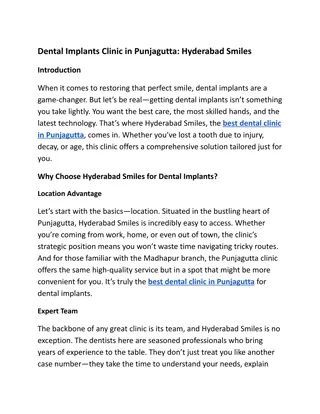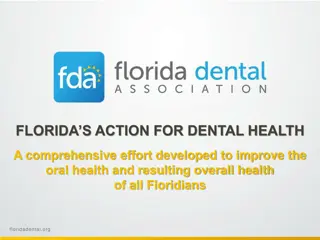
Gum Disease Treatment in saraf dental clinic
Gum disease can lead to discomfort and serious dental issues if left untreated. Dr. Shreya Saraf, a specialist in periodontology, shares key signs to watch for, including swollen or bleeding gums, bad breath, and loose teeth. For personalized care, v
Download Presentation

Please find below an Image/Link to download the presentation.
The content on the website is provided AS IS for your information and personal use only. It may not be sold, licensed, or shared on other websites without obtaining consent from the author. Download presentation by click this link. If you encounter any issues during the download, it is possible that the publisher has removed the file from their server.
E N D
Presentation Transcript
Gum Disease ( ): Comprehensive Guide on Symptoms, Causes, Prevention, and Treatment Gum disease, also known as periodontal disease ( ), is a serious oral health condition that can lead to tooth loss if left untreated. It is a progressive disease that starts with gum inflammation (gingivitis) and can advance to affect the bone that supports your teeth (periodontitis). This blog, with insights from Dr. Shreya Saraf, a renowned Periodontologist in Satna, Madhya Pradesh, covers everything you need to know about gum disease, including symptoms, causes, stages, prevention, and available treatment options. What is Gum Disease? Gum disease is an infection of the tissues that hold your teeth in place. It is primarily caused by poor oral hygiene, which allows plaque a sticky film of bacteria to accumulate on the teeth and harden into tartar. If plaque is not removed through regular brushing and flossing, it can lead to inflammation and infection in the gums. Symptoms of Gum Disease ( ) Dr. Shreya Saraf emphasizes the importance of recognizing the early signs of gum disease to prevent further complications. The common symptoms include: 1. Swollen Gums ( ) One of the earliest signs of gum disease is swollen or puffy gums. Healthy gums should be firm and pink, but inflamed gums appear red, swollen, and tender to the touch. 2. Bleeding Gums ( )
Gums that bleed during brushing, flossing, or eating hard foods are a warning sign of gingivitis, the early stage of gum disease. 3. Receding Gums ( ) As gum disease progresses, the gums begin to recede or pull away from the teeth, exposing more of the tooth's surface or even the roots. This can cause increased sensitivity. 4. Persistent Bad Breath ( ) Chronic bad breath or a foul taste in the mouth can result from the bacterial infection under the gum line. 5. Loose or Shifting Teeth ( ) In advanced stages, the gums and bone that hold the teeth in place deteriorate, causing the teeth to become loose or even fall out. 6. Pain While Chewing ( ) Pain during chewing is another symptom of periodontitis, indicating that the disease has affected the underlying bone. Causes of Gum Disease Gum disease develops when plaque accumulates on the teeth and hardens into tartar. The bacteria in plaque release toxins that irritate the gums. Factors contributing to the development of gum disease include: 1.Poor Oral Hygiene: Inadequate brushing and flossing allow plaque to build up. 2.Smoking or Tobacco Use: Tobacco use is a major risk factor for gum disease as it impairs the immune system. 3.Hormonal Changes: Fluctuations in hormones, such as during pregnancy, puberty, or menopause, make gums more sensitive. 4.Genetic Predisposition: Some individuals are genetically more susceptible to gum disease. 5.Medical Conditions: Conditions like diabetes, cancer, and HIV can increase the risk of gum disease. 6.Medications: Certain medications reduce saliva flow, which helps protect gums. 7.Poor Nutrition: A diet lacking essential nutrients weakens the immune system, making it harder to fight off infection. Stages of Gum Disease 1.Gingivitis: oThe mildest form of gum disease, characterized by red, swollen, and bleeding gums. oIt is reversible with proper oral care and professional cleaning. 2.Periodontitis: oAt this stage, the inner layer of the gum and bone pull away from the teeth, forming pockets that collect debris and become infected. oThe body's immune response and bacterial toxins break down the bone and connective tissue. 3.Advanced Periodontitis: oIn the final stage, the supporting bone and gum tissues are destroyed, leading to loose teeth, which may fall out or require removal.
Treatment Options for Gum Disease According to Dr. Shreya Saraf, early detection and treatment are crucial to preventing tooth loss. Treatment depends on the severity of the condition and may include: 1. Non-Surgical Treatments Professional Cleaning (Scaling and Root Planing): This deep-cleaning method involves removing plaque and tartar from above and below the gum line. Root planing smooths rough spots on the roots where bacteria gather. Medications: Antibiotics may be used to control bacterial infection. These can be in the form of mouth rinses or oral antibiotics. 2. Surgical Treatments Flap Surgery (Pocket Reduction Surgery): The gums are lifted back to remove tartar and then sutured to fit snugly around the teeth. Bone Grafting: If the bone around the teeth has been destroyed, grafting procedures can help regenerate bone. Soft Tissue Grafts: Tissue is taken from the roof of the mouth to cover exposed roots or reinforce thinning gums. Guided Tissue Regeneration: A regenerative procedure that allows bone regrowth when the bone supporting the teeth has been destroyed. Preventive Measures to Maintain Healthy Gums Prevention is the best approach to gum disease. Dr. Shreya Saraf suggests the following measures to keep your gums healthy: 1.Brush Twice Daily: Use a fluoride toothpaste and a soft-bristled toothbrush to clean your teeth thoroughly. 2.Floss Daily: Flossing removes plaque and food particles from between the teeth where a toothbrush can t reach. 3.Use Antimicrobial Mouthwash: Rinsing with an antimicrobial mouthwash can reduce plaque and prevent gingivitis. 4.Eat a Balanced Diet: A diet rich in vitamins and minerals supports healthy gums. Avoid sugary snacks and drinks. 5.Avoid Tobacco Products: Smoking weakens the immune system, making it harder to fight off gum infection. 6.Regular Dental Visits: Visit your dentist regularly for professional cleanings and check-ups. Contact Dr. Shreya Saraf for Expert Care For professional diagnosis and treatment of gum disease, reach out to Dr. Shreya Saraf, an experienced Periodontologist offering expert care in Satna, Madhya Pradesh.
?Phone: +91 7987791345 ?Location: Railway Station Road, Satna, Madhya Pradesh, 485001 Conclusion Gum disease is a common but preventable condition that can have serious consequences if ignored. Early detection, proper oral hygiene, and regular dental visits are key to maintaining healthy gums and preventing tooth loss. Don t wait until it's too late schedule an appointment with Dr. Shreya Saraf today to ensure your gums and teeth stay healthy for a lifetime.






















